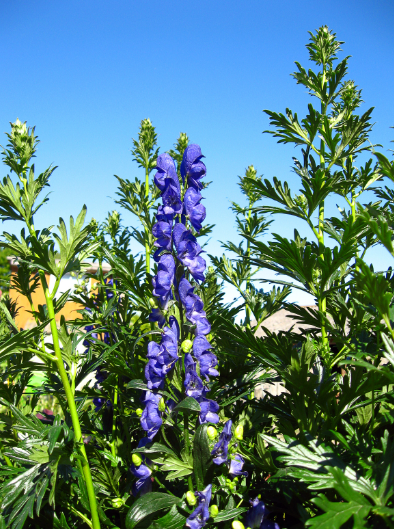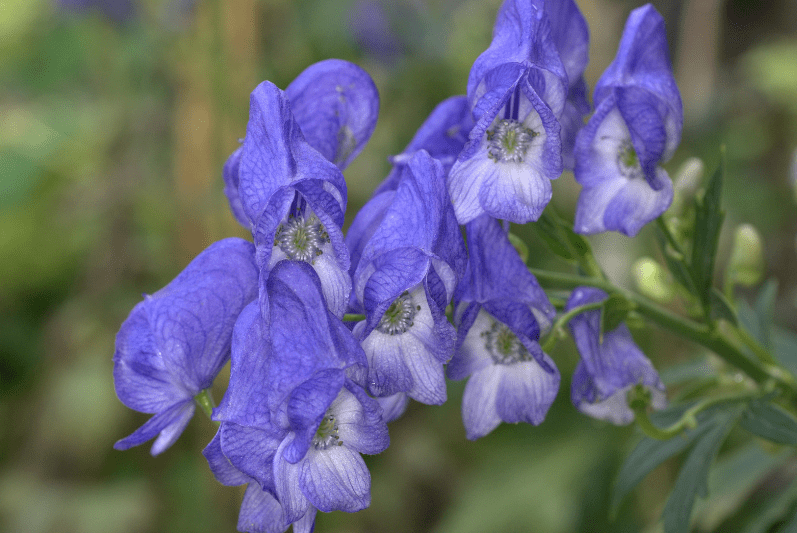The Enigmatic Monkshood
Cultivation, Ecology, and Beyond
Monkshood (Aconitum spp.), renowned for its striking hood-shaped flowers and rich historical tapestry, is a plant that has fascinated gardeners, ecologists, and historians for centuries. This perennial herb, belonging to the Ranunculaceae family, is as intriguing as beautiful.
We’ll delve into the intricacies of cultivating monkshood, explore its ecological significance, and dissect its physical characteristics—mainly focusing on the common monkshood (Aconitum napellus)—navigate its taxonomy, understand its toxic properties, and appreciate its role in medicine and culture.
Cultivation
Nurturing the Mysterious Beauty
Growing monkshood requires patience, knowledge, and respect for its unique needs.
Climate Considerations
Monkshood thrives in temperate climates, preferring cool summers and mild winters. It is hardy in USDA zones 3-7, making it suitable for various geographical areas. The plant is well-adapted to regions with consistent moisture and can tolerate cold temperatures, reflecting its native mountainous habitats.
Soil Preparation
A well-draining, humus-rich soil with a slightly acidic to neutral pH (6.0-7.0) is ideal. Incorporate organic matter such as compost or leaf mold to enhance soil fertility and structure. Good soil preparation is crucial for the development of its tuberous roots.
Planting Depth and Propagation Methods
- Planting Depth: Plant the tubers or root divisions about 3 inches deep, ensuring the buds are covered.
- Propagation: While monkshood can be grown from seed, which may take several years to flower, division of tuberous roots in early spring or fall is more common. This method helps maintain the characteristics of specific hybrids and cultivars.
Sunlight Requirements
These plants prefer partial shade, especially in hotter climates. In regions with cooler summers, they can tolerate more sunlight. Too much sun can stress the plant, leading to scorched leaves and diminished flowering.
Watering Schedule
Maintain consistent moisture without waterlogging. A regular watering schedule that keeps the soil evenly moist is crucial, particularly during dry spells. Mulching can help retain soil moisture and regulate temperature.
Fertilizer Application
Apply a balanced, slow-release fertilizer in early spring to support growth. A fertilizer ratio of 10-10-10 can provide the necessary nutrients without promoting excessive foliage at the expense of flowers.
Pruning Techniques and Seasonal Care
- Pruning: Remove spent flower clusters promptly to encourage additional blooms and prevent self-seeding, which can lead to overcrowding.
- Seasonal Care: In autumn, after the foliage dies back, cut the stems to ground level. Mulching in winter protects the roots from extreme cold and temperature fluctuations.
Companion Planting
Monkshood pairs well with other shade-loving plants such as hostas, ferns, and astilbes. These companions not only complement its aesthetic appeal but also share similar growing conditions.
Pest Control and Disease Management
- Pests: Generally resistant to pests, but occasional issues with aphids, slugs, and snails may occur.
- Diseases: Ensure good air circulation to prevent fungal diseases like powdery mildew and root rot. Avoid overhead watering to reduce moisture on the foliage.
Ecology
Monkshood in Its Natural Habitat
Understanding the ecological role of monkshood enhances our appreciation of this plant.
Native Range and Habitat
Monkshood is native to the mountainous regions of Europe, Asia, and North America, thriving in cool, moist woodlands, meadows, and along stream banks. Its presence in these ecosystems contributes to the biodiversity and overall health of the habitats.
Altitude Range and Climate Conditions
It typically grows at elevations ranging from 2,000 to 10,000 feet, where climate conditions offer cooler temperatures, higher humidity, and protection from intense sunlight. These environments mimic the plant’s preference for partial shade and consistent moisture.
Soil Type and Biodiversity
Preferring rich, loamy soils, monkshood often grows in soils enriched by decaying organic matter from surrounding vegetation. Its growth contributes to the biodiversity of plant life, supporting various microorganisms and soil health.
Ecosystem Role and Wildlife Interactions
Despite its toxicity, monkshood plays a role in supporting specific pollinators, such as bumblebees, which have the strength to navigate its complex flowers. These interactions are crucial for the plant’s reproduction and the sustenance of pollinator populations.
Conservation Status
Some species, like the Northern Blue Monkshood (Aconitum noveboracense), are considered threatened due to habitat loss, climate change, and human activity. Conservation efforts are essential to preserve these species and their ecological roles.
Physical Description
The Allure of Monkshood
Monkshood’s distinct appearance sets it apart in any garden, with the common monkshood (Aconitum napellus) being particularly notable.
Flower Characteristics
- Flower Clusters: The plant produces tall, erect spikes called racemes, adorned with numerous flowers.
- Colors: The common monkshood boasts deep indigo-blue flowers, although some varieties display straw-yellow or whitish blooms.
- Structure: Each flower has five petal-like sepals, with the upper sepal forming a characteristic hood that arches over the rest of the flower. This hood conceals the true petals, which are modified into nectaries.
Foliage and Roots

- Leaves: The plant features dark green, deeply lobed leaves with toothed margins, arranged spirally around the stem. The foliage adds to the plant’s ornamental value even when not in bloom.
- Roots: Monkshood has a tuberous root system, which is thick and fleshy. These roots store nutrients but also contain the highest concentration of toxic compounds.
Morphology
The common monkshood can reach heights of 3 to 5 feet, with sturdy, unbranched stems. Its robust stature and striking flowers make it a focal point in garden designs.
Taxonomy and Species
A Diverse Genus
Monkshood encompasses a variety of species, each with unique traits.
Classification
- Family: Ranunculaceae
- Genus: Aconitum
- Species: Over 250 species, with significant diversity in form and habitat.
Major Species
- Aconitum napellus: Known as the common monkshood, native to Europe, and widely cultivated for its ornamental value.
- Aconitum carmichaelii: Native to East Asia, it flowers later in the season, extending the bloom period of monkshoods in the garden.
- Aconitum fischeri: A shorter species with pale blue flowers, suitable for smaller gardens.
- Aconitum hemsleyanum: Notable for its climbing habit, often reaching heights over 6 feet.
- Aconitum anthora: also known as yellow monkshood, is identifiable by its pale yellow flowers.
- Aconitum columbianum: Native to North America, found in the western regions.
Perennial Herbs
All species are perennial herbs, returning each year with proper care. Their longevity and minimal maintenance make them valuable additions to perennial borders and woodland gardens.
Toxicology
Handle with Care
Monkshood is infamous for its toxic properties, necessitating caution.
Toxic Compounds
- Alkaloids: The plant contains potent alkaloids, primarily aconitine, which is a neurotoxin and cardiotoxin.
- Fleshy Roots: The highest concentration of toxins is found in the roots and seeds, but all parts of the plant are poisonous.
Effects on Humans and Animals
Exposure can lead to symptoms such as numbness, tingling, nausea, and in severe cases, heart failure and respiratory paralysis. Ingestion can be fatal, and even skin contact can cause adverse reactions due to the toxin’s ability to be absorbed transdermally.
Safety Measures
- Gloves: Always wear protective gloves and long sleeves when handling the plant to prevent skin absorption.
- Awareness: Educate family members and visitors, especially children and pets, about the dangers of the plant.
- Disposal: Dispose of plant material carefully. Do not compost; instead, bag and discard to prevent accidental contact.
Historical Use as a Poison and Medicine
Throughout history, monkshood has been used both as a poison and in traditional medicine:
- Poison: In ancient times, it was used on arrow tips and in bait to poison predators and enemies. Notably, it was a favored poison in ancient Greek and Roman times.
- Medicine: Despite its toxicity, it was used in small, controlled doses to treat ailments like neuralgia, rheumatism, and fever. Its use in medicine has largely been discontinued due to the high risk of poisoning.
The historical use of monkshood as a poison and medicine is rich and fascinating. It was known as “aconite” in ancient Greece and was associated with the goddess Hecate. It was used to poison arrows and spears and was also administered to criminals as a form of execution.
Roman physicians used monkshood to treat various ailments, including gout, rheumatism, and epilepsy. However, its use was often fraught with danger due to its toxicity.
Anecdote: One famous example of monkshood’s use as a poison is the death of Socrates. According to Plato’s Phaedo, Socrates was forced to drink a hemlock potion, which is believed to have contained monkshood. This event has become a symbol of philosophical courage and the acceptance of death.
Uses in Medicine and Culture
Despite its toxicity, monkshood has been the subject of ongoing research into its potential medicinal applications. Some studies have suggested that certain compounds found in monkshood may have anti-inflammatory, analgesic, and antitumor properties.
However, it is essential to note that these studies are in the early stages, and more research is needed to fully understand the potential benefits and risks of using monkshood for medicinal purposes.
Caution: It is crucial to emphasize that monkshood is a highly toxic plant and should never be used for medicinal purposes without the guidance of a qualified healthcare professional.
Folk Medicine
In traditional Chinese medicine, species like Aconitum carmichaelii are processed (to reduce toxicity) and used to treat conditions such as joint pain and heart ailments. However, due to the high risk, such uses are controversial and require expert handling.
Literature and Popular Culture
Monkshood appears in literature and folklore, often associated with mystery and danger:
- Mythology: In Greek mythology, monkshood is said to have sprung from the saliva of Cerberus, the three-headed dog guarding the underworld.
- Literature: featured in works by authors like Agatha Christie, where it serves as a plot device due to its lethal properties.
- Symbolism: Often symbolizes caution, misanthropy, or a deadly beauty.
Mysticism
In various cultural myths, monkshood has been linked to protection against werewolves and witches, reflecting its aura of mystique and supernatural associations.
Conclusion
Monkshood is a plant of paradoxes—beautiful yet deadly, familiar yet mysterious. Whether you’re a gardener looking to cultivate its striking blooms, an ecologist studying its role in mountain ecosystems, or a historian intrigued by its cultural significance, monkshood offers a wealth of knowledge and fascination.
Its history as a medicine and a poison underscores the importance of respecting nature’s power. Always remember to handle with care, acknowledging both its allure and its potential dangers.
Disclaimer: Monkshood is a highly toxic plant. This article is for informational purposes only. Always exercise caution and consult professionals when handling or cultivating monkshood.



























